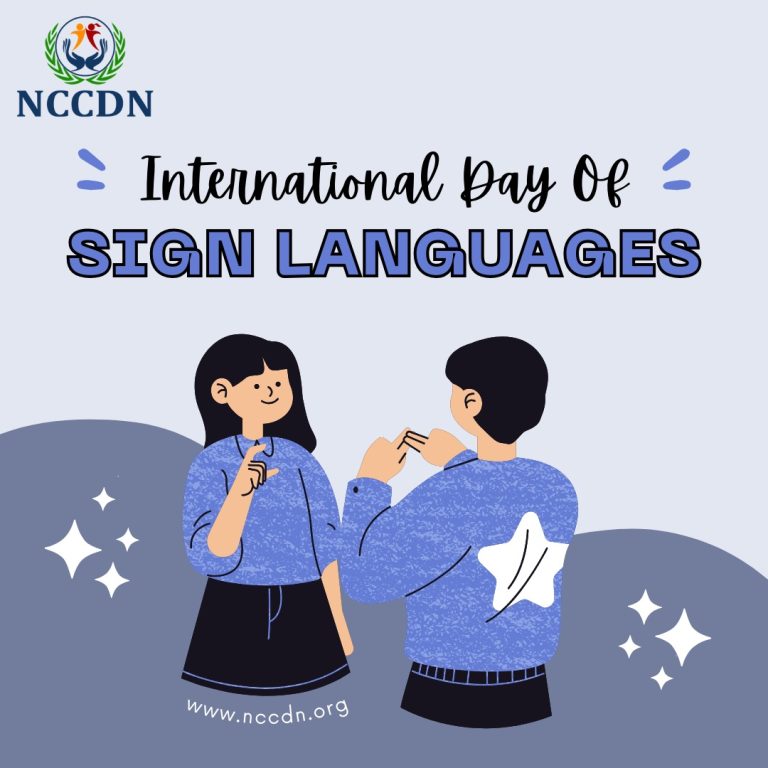NCCDN Honors International Sign Language Day for Holistic Child Development

The New Center for Child Development and Nutrition (NCCDN) is pleased to recognize International Sign Language Day. This occasion underscores our ongoing commitment to advancing comprehensive child development through accessible and inclusive communication strategies. We view sign language as more than a resource for those who are deaf or hard of hearing. It’s an invaluable tool that supports cognitive, social, and emotional growth for all children. By integrating sign language into our programs, we aim to empower every child to communicate effectively. Also they can express themselves, and reach their full developmental potential within our community.
NCCDN Champions Inclusive Communication on International Sign Language Day
Recognizing International Sign Language Day is far more than a symbolic act for NCCDN. It’s a cornerstone of our commitment to comprehensive early childhood education. We view sign language as an essential component that directly supports cognitive development. The research is clear: introducing sign language at an early age stimulates brain activity in multiple regions. Which, in turn, strengthens visual-spatial reasoning, memory, and problem-solving skills.
For infants and toddlers who are not yet verbal, sign language serves as a crucial communication bridge. Early access to expression significantly minimizes frustration for both children and their caregivers, promoting a secure and trusting relationship. When young children can communicate their needs—whether it’s hunger, discomfort, or something else. Before they develop speech, they’re more likely to build emotional regulation and self-confidence from the very beginning. That’s why NCCDN invests in sign language workshops for parents and interactive sessions for children. This approach not only accelerates language acquisition, but also fosters a flexible, resilient brain.
Ultimately, our multi-modal language strategy ensures an inclusive, supportive developmental journey for all children. By integrating sign language into our programs, we build a foundation where cognitive growth and emotional well-being.
Unlocking Cognitive Potential: The Neurological Benefits of Sign Language
Let’s cut to the chase—yes, sign language offers big cognitive perks. But at NCCDN, we see it as a strategic asset for social-emotional development. Our programs aren’t off-the-shelf; they’re purpose-built to foster genuine connection and inclusivity across all children, regardless of hearing ability.
When students learn sign language, they’re not just expanding their vocabulary—they’re developing a broader appreciation for diverse communication styles. This skill set breaks down barriers between deaf, hard-of-hearing, and hearing students. They are paving the way for more collaborative and harmonious classroom and playground environments.
Our approach? We integrate spoken and signed communication into group activities and storytelling, making sure every child participates fully. No one’s left out due to communication differences. This shared language experience creates a strong sense of community and belonging, which is crucial for building confidence.
At NCCDN, we actively position sign language as more than a tool—it’s a catalyst for friendship, and mutual respect. By embedding sign language into daily learning and interaction, we’re laying the groundwork for a more inclusive and emotionally intelligent society—one that benefits not just individuals, but the broader community and future workforce.
Building Bridges of Empathy: Sign Language as a Tool for Social-Emotional Growth
Here’s how things work at the New Center for Child Development and Nutrition: we don’t just look at one piece of the puzzle—we tackle the whole picture. Our strategy combines nutrition, development, and communication because, frankly, you can’t have one thriving without the others.
If you want a child to learn, remember, and develop complex skills like signing, their brain needs the right fuel. Nutrients such as Omega-3s, iron, and protein aren’t optional extras; they’re the foundation for building healthy neural pathways that support everything from memory to the fine motor skills for articulate signing.
Our team of experts works closely with families, offering tailored nutritional guidance to foster this essential brain development. At the same time, we empower children with sign language skills, enabling them to clearly express when they’re hungry, full, or have specific food preferences. This ability to communicate needs doesn’t just make life easier—it actively improves nutritional outcomes by ensuring parents and caregivers can respond effectively.
To support this, we offer joint workshops where nutritionists and speech-language pathologists collaborate, showing parents how to combine healthy mealtime habits with communicative signing for smoother, less stressful experiences.
Conclusion
Celebrating International Sign Language Day isn’t just a date on the calendar for NCCDN—it’s a clear reflection of our core mission. We’re deeply committed to supporting every aspect of a child’s development, and sign language is a critical part of that strategy. It’s not simply an add-on; it directly boosts cognitive growth, strengthens social and emotional skills, and, when combined with proper nutrition, supports overall well-being.
Our approach isn’t about quick fixes or focusing on isolated challenges. Our vision goes further than our doors—we’re actively encouraging parents, educators, and community leaders to see sign language as a vital resource. It’s an essential tool for inclusion, effective communication, and unlocking the talents of every child.
Looking ahead, NCCDN is committed to expanding sign language resources and developing innovative programs that blend communication, nutrition, and behavioral support. By building an environment where every child is recognized and understood, we’re empowering them to grow into confident and resilient individuals. Our ongoing efforts are focused on celebrating all forms of communication and ensuring that every child has the opportunity to succeed.
We hope you like the article. For reading more articles and blogs, click on the link https://nccdn.org/. You can follow us on Facebook, LinkedIn, Twitter, and Instagram.
RECENT POST
- October 10, 2025
- September 29, 2025
- September 27, 2025
- September 27, 2025
